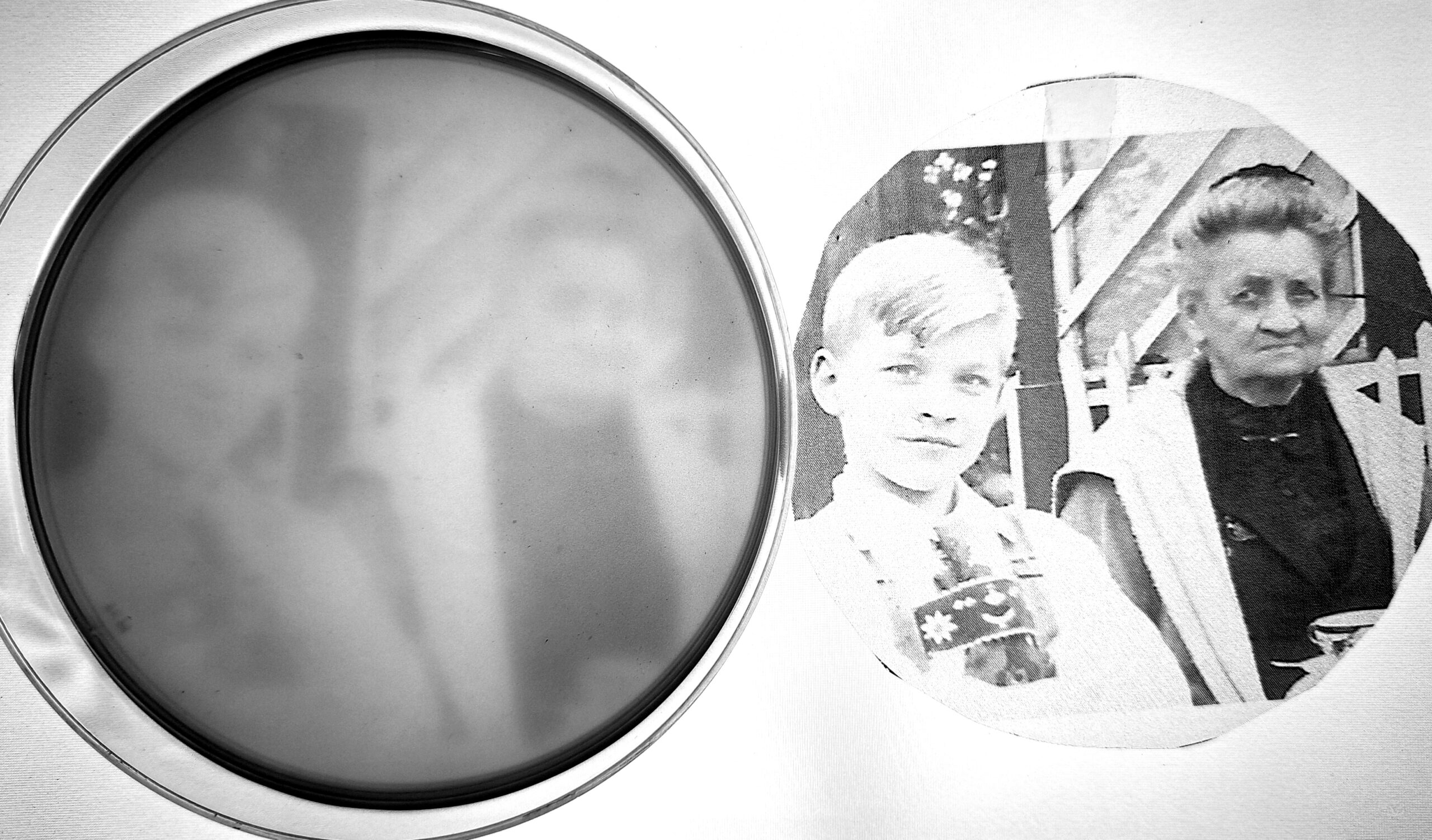Wow, how time flies! It’s already been over two weeks since I attended Global Engage’s microbiome and probiotics conference. The two-day event was packed with riveting talks and bountiful networking opportunities. Amid a sea of talks and discussions, a massive deluge of updates in microbiome, probiotics, and live biotherapeutic product (LBP) R&D stood in the spotlight. As I capitalized on the opportunity to hear from the world’s leaders in microbiome research, I felt a deeper appreciation for the microbes that keep our bodies healthy. Just as important in these talks was the potential to develop microbes as viable options for boosting a person’s health and treating human diseases.
The mosaic of R&D efforts to harness the gut and skin microbiota for health produced a conference to remember. All manner of new insights in gut health, probiotics, and LBP development were being shared, and I had the perfect chance to soak it all in. With that in mind, let me give you a highlight reel of some of the most interesting talks and events that took place at Global Engage’s 10th Microbiome and 7th Probiotics Forum in Miami.
First impressions
The first morning of the conference saw me entering a single room that served as the central point for the conference. As I enjoyed an egg sandwich for breakfast, I observed a room filled with exhibitions and representatives eager to share their wares. I was first met with a large anaerobe chamber distributed by Microbiology International that was designed to grow and process LBPs and probiotics in the production pipeline (Figure 1). I even had a chance to try out the anaerobe chamber, much the same way I did when I worked with an anaerobic chamber in my doctorate days.
At the other side of the room, my eyes caught a glance of the stand from Manda Fermentation USA Inc. (Figure 1). The company shared their superdrink powder which I had the pleasure of trying after I got back from Miami. The powder mix comprised of green leaves and Lactobacillus bacteria for mitigating symptoms such as constipation and enhancing gut health.
A few days after I got back from Miami, I decided to give the powder a try. I mixed the green powder with a cup of water and shared the drink with my dad. A taste of the probiotic/prebiotic drink reminded me of green tea. It was a far more savoury and familiar taste than I expected. If the powder mix came to Canada, I wouldn’t mind trying it to see whether it improves my gut health in the long run. Even so, with such friendly interactions and a tasty breakfast, I knew this conference would be one I wouldn’t forget.
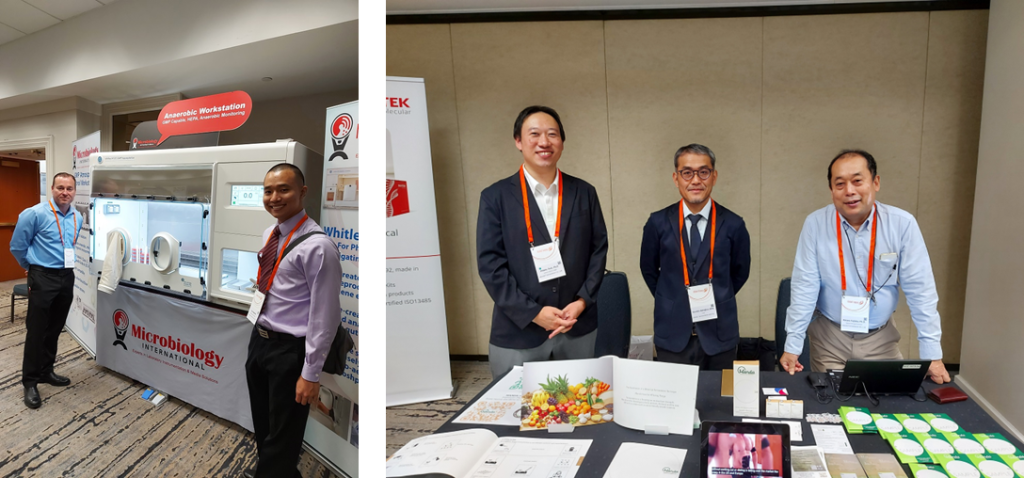
Probiotics: harnessing bacteria to enhance well-being
After my first breakfast in Miami, the rest of the day saw me attending a series of talks on probiotics evenly spread throughout the day. There was a talk held by Dr. Christopher Damman about his prebiotic shake for one (Figure 2). To learn more about that talk, you can follow this link to my interview with Christopher. Dr. Mark Haupt also gave a talk about the scourge of metabolic syndrome and how it contributes to fatty pancreas disease as well as fatty liver disease. I will talk more about this on my interview with him that I plan to publish soon.
Nevertheless, the talk that I found myself drawn to most among the probiotic talks was the one given by Dr. Virginia Riquelme from Diversigen (Figure 2). There, she talked about a new kind of canned soda and root beer called Olipop. This isn’t your typical soft drink. You see, it’s packed with 8 prebiotics designed to be “a healthier, gut-friendly option for soda drinkers,” according to Olipop. With this drink, Diversigen saw the opportunity to study the impacts of feeding people the prebiotic-enriched drink to their gut microbiomes. The coolest finding was the fact that among the Olipop-drinking participants, they identified an increased abundance of genes encoding enzymes capable of breaking down resistant starch in their samples (ie. amylase and hemicellulase). Alongside that finding, Diversigen also observed increased abundances of Bifidobacterium species capable of breaking down resistant starch. This finding was particularly interesting because the species releases short-chain fatty acids (SCFAs) known to improve bodily health after metabolizing resistant starch.
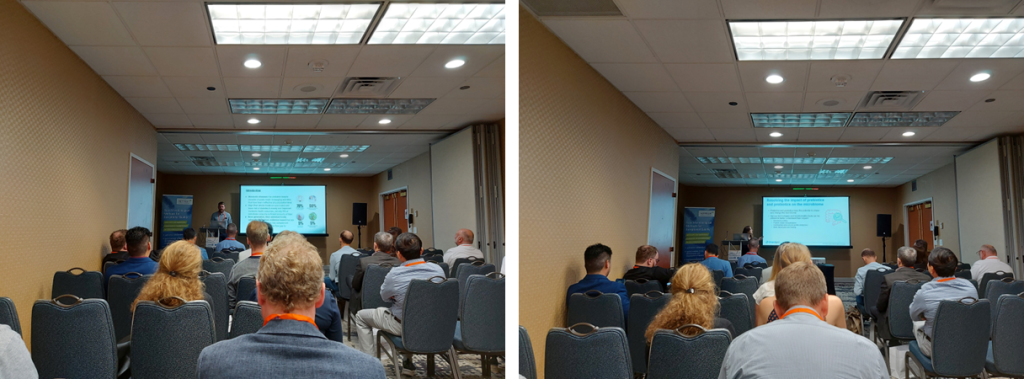
Using live bacteria and fecal slurries to treat disease
The first day of the conference also saw me attending a series of talks focused on harnessing the therapeutic potential that bacteria affords. There, I was introduced to two contract development and manufacturing organizations (CDMOs), Richard Ellis from Biose Industrie and Nick Mazzucca from ArrantaBio. As a quick primer, CDMOs are companies and organizations that handle the R&D for developing a drug (in this case, live biotherapeutics (LBPs)) and producing it. Both told stories of how they sought to develop new LBPs and development pipelines to maximize bacterial yields and minimize bacterial contamination. Other talks also focused on fecal microbiome transplantation (FMT), an emerging therapeutic approach for improve intestinal disease outcomes. Amid the promise, Dr. Sahil Khanna also states the importance of screening for enteric pathogens before selecting an FMT donor (Figure 3). I discuss more about this in my interview with the Mayo Clinic professor.
Amid a sea of talks about leveraging the gut microbiota, I found myself most drawn into H. Bjørn Nielsen’s talk (Figure 3). Representing Clinical Microbiomics, Bjørn gave a thought-provoking talk about the ability to tease apart bacteria down to the clonal level. As a quick intro, bacterial strain represent a genetic subtype of a species. As an analogy, while all humans share a common genomic structure, we also have genetic variants that contribute to the diverse groups of people we encounter in our daily lives.
Now, Clinical Microbiomics showed that they were able to take this delineation to the next level, down to an individual population of a strain called a clone. They applied this approach to study the diversity of Bifidobacterium infantis strains worldwide by identifying single-nucleotide variants (SNVs) in genes only found in all members of this species. The promise in this work enables more targeted efforts to refine existing LBP and probiotic R&D to improve a person’s health.
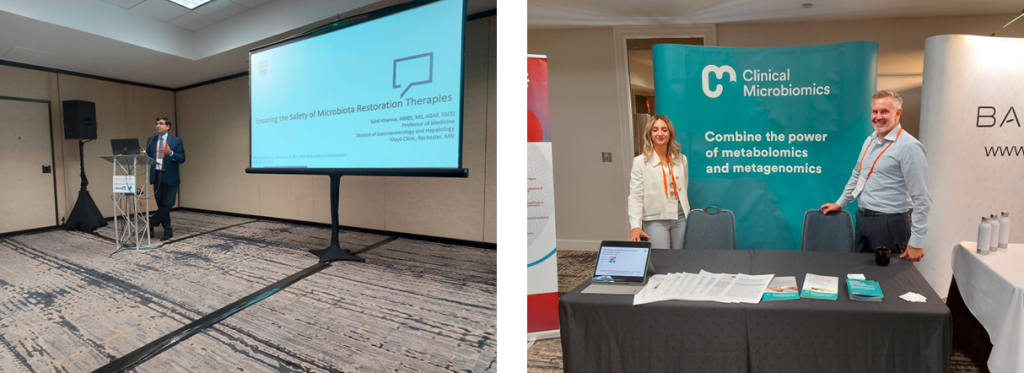
Under your skin: The skin microbiome talks
Alongside the microbiome and probiotics talks, I also had a chance to attend a series of talks about the skin microbiome. On the second day of the conference, I found myself listening to speakers introducing their microbiome-based skin products. This included an engaging talk by AOBiome’s CEO, Todd Krueger, who introduced ammonia-oxidizing bacteria (AOB) as a promising microbiome-based therapeutic for mild-to-moderate acne (Figure 4). The approach relies on AOBs converting ammonia into nitric oxide, a compound that improves wound healing by preventing wounds from growing before healing begins. What I found most interesting about Todd’s talk were the many considerations that he and everyone else at AOBiome had to think about when producing probiotics and LBPs. A company has to prepare a way to deliver the drug, the cell density and stability achieved, and its potency for treating the skin condition.
That interest also pervaded the panel discussions that occurred later in the morning (Figure 4). The discussion sought to move towards resolving some of the obstacles associated with investing in skin microbiome therapeutics. I found it particularly interesting that the panelists mentioned an air of skepticism and aversion to risk that pervades these kinds of therapeutics. Additionally, while there is some excitement going from venture capitalists, the incoming recession led them to reserve capital for existing investments. It wasn’t all hopeless, however. The efforts to brainstorm new approaches to improve the effectiveness and safety of skin probiotics and LBPs provided hope for a new creative spring to rise up from within the industry.
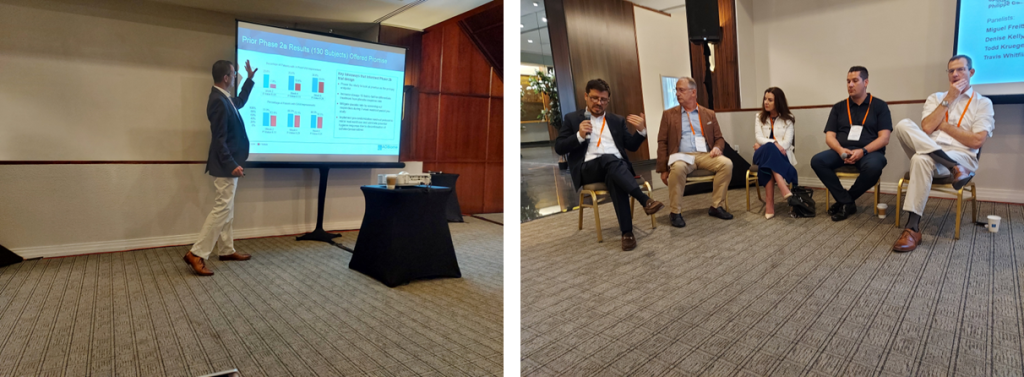
The exhibitions
In each of our morning, lunch, and afternoon breaks, I had the chance to interact with the many people representing the conference’s sponsors. Since many of the sponsors also gave talks at the conference, the exhibitions served as a great opportunity to get one-on-one meetings with the companies leading the way in probiotic development, production, and sales. Some of the exhibits took on a creative look, like a phage made of candy from Phage Consultants (Figure 5). Others provided samples of their products and other great souvenirs ranging from pens to bottles to notebooks! Check out my social media posts on Linkedin if you want to learn more about the companies that were there!
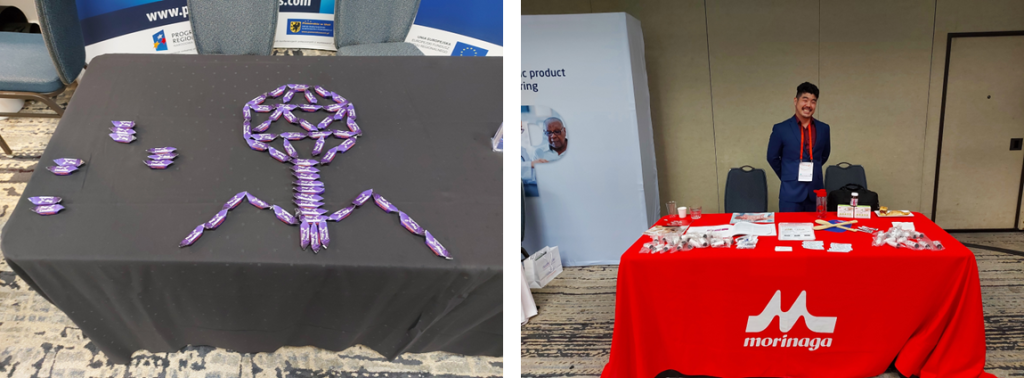
Concluding remarks
When I saw that the conference was two days long, I was skeptical at first. How could one get through so much networking and learning in such a short frame of time? My first conference experience was in Boston, featuring 4 days of microbiology R&D, so I wondered how one could fit everything in a relatively short conference.
But I was proven wrong. With it being two days long, I found myself adding to my network as much as I could. I got to work, getting in touch with people I never met before and learning from their expertise in microbiome and probiotics R&D. I was also given a thorough introduction to the probiotics and LBP industries. I even had a chance to harness some of my German to talk with a few companies. Vielen dank für ihre Gastfreundschaft (Thank you for your hospitality)!
It’s safe to say that I will be back for more microbiome and probiotics conferences next year. I look forward to continue spreading the word about the great advancements being made in the probiotics and LBP industries and in microbiome research. See you soon!
Author
-
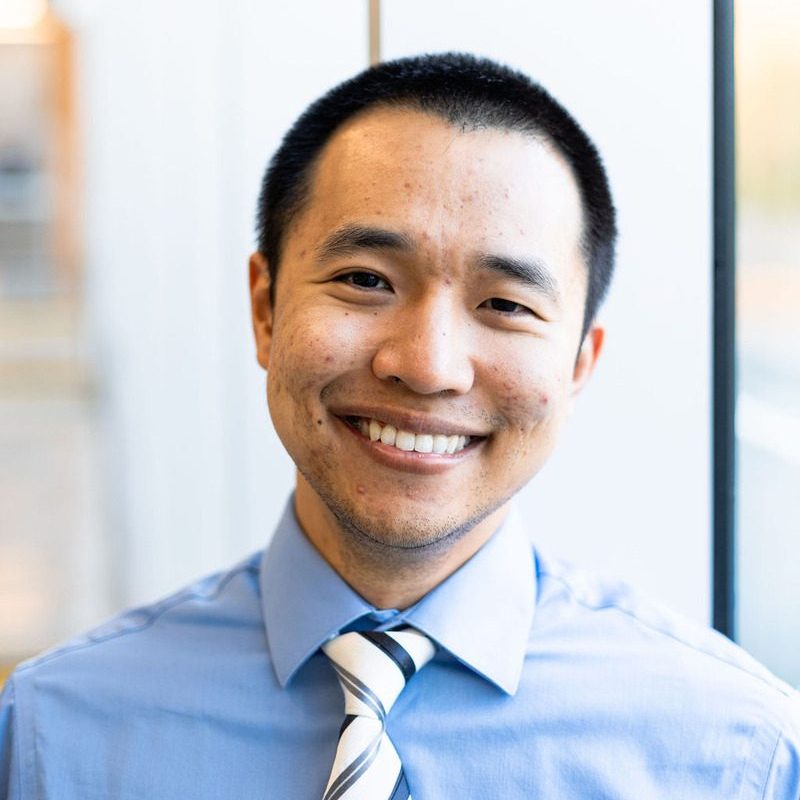
Paul Naphtali is a seasoned online marketing consultant. He brings to the table three years of online marketing and copywriting experience within the life sciences industry. His MSc and PhD experience also provides him with the acumen to understand complex literature and translate it to any audience. This way, he can fulfill his passion for sharing the beauty of biomedical research and inspiring action from his readers.
View all posts

